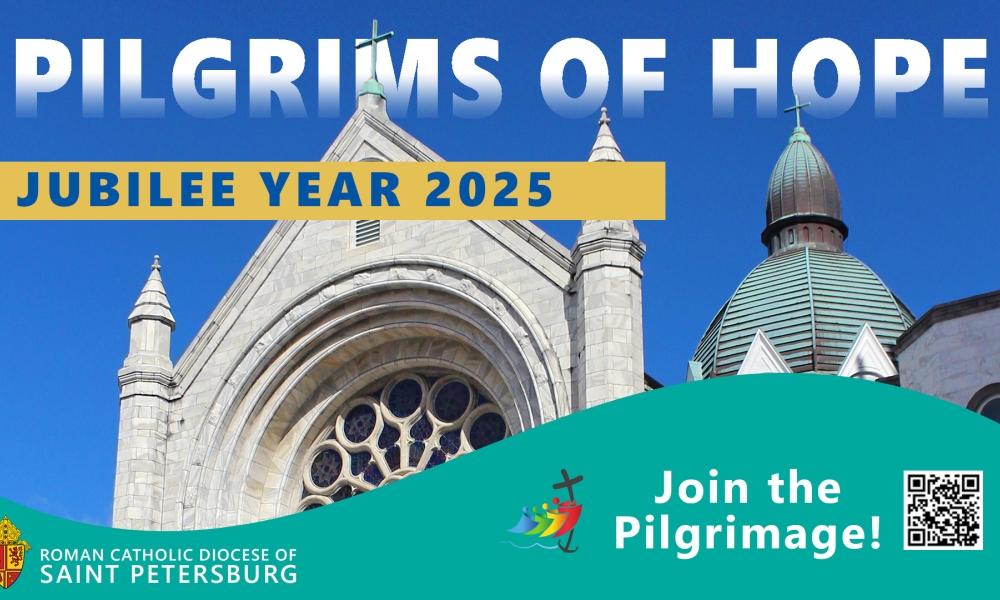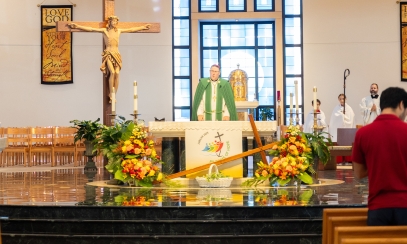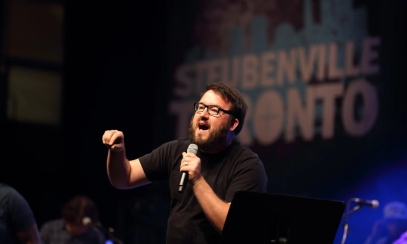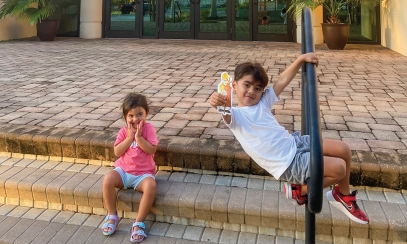
Six Sacred Sites in the Diocese of Saint Petersburg are Places of Pilgrimage during the Jubilee Year
Getting your Trinity Audio player ready...Catholics may receive a Plenary Indulgence for visiting these sacred sites.
Catholics may receive a Plenary Indulgence for visiting these sacred sites.
Bishop Gregory Parkes has designated six churches as official Places of Pilgrimage for the Jubilee Year. In 2025, Catholics are invited to become Pilgrims of Hope and reflect on their journey of faith towards Christ as they visit local places of pilgrimage.
Pilgrimages are a powerful way to inspire faith whether by walking in the footsteps of Jesus in the Holy Land, visiting the tombs of saints, or visiting ancient churches. In the western counties of Florida, Catholicism has been prevalent for nearly 500 years and our diocese has been home to missionaries, martyrs, and those seeking religious freedom.
During a Jubilee Year, Catholics can receive a Jubilee indulgence granted by Pope Francis for making a pilgrimage, as well as making an act of penance, going to confession, receiving Communion, making a profession of faith, and praying for the intentions of the Holy Father. The Code of Canon Law describes an indulgence as, "a remission before God of the temporal punishment for sin, the guilt of which is already forgiven" (canon 992).
There is one pilgrimage site designated for each of the five counties of the Diocese of Saint Petersburg, plus the Cathedral of St. Jude the Apostle, the mother church of all Catholics in union with our bishop.
The six pilgrimage sites are listed below. Near the entrance to each church, visitors can find a Pilgrims of Hope Passport with the Jubilee Prayer and other information about the sacred sites. The "Passport" can also be printed here.
Mother Church: Cathedral of St. Jude the Apostle (Celebrating 75th Anniversary in 2025)
5815 5th Ave N, St. Petersburg
General Hours: Monday through Friday 7:30 a.m. to 2:15 p.m., Saturday 9:30 a.m. – 5:30 p.m., Sunday 7 a.m. – 7:30 p.m.
The growth of Florida’s population led to the establishment of the Diocese of Saint Petersburg on June 17, 1968. The Parish of St. Jude was elevated to cathedral status for the newly formed diocese by Pope Paul VI. St. Jude Parish officially became the Cathedral of St. Jude the Apostle with the appointment and installation of Bishop Charles B. McLaughlin as the first Bishop of St. Petersburg on May 8, 1968.
One striking feature of the Cathedral’s architecture is the 24-foot-high stained-glass window behind the altar. A circular glass motif serves as a backdrop for the cathedral's gold-plated tabernacle. A beautiful dome is supported by massive steel beams. Some of the notable works of art include a stunning mosaic depicting the landing of Father Juan Xuarez in St. Petersburg in 1528. The Spanish missionary priest was the first Catholic bishop who was appointed to serve in the United States. In 2013, following a series of renovations, the Cathedral Church was reopened and dedicated by Bishop Robert Lynch.
Pinellas County: Espiritu Santo Catholic Church
2405 Philippe Parkway, Safety Harbor
General Hours: Monday - Thursday 7:00 a.m. – 4:00 p.m., Friday 7:00 a.m. – 2:00 p.m., Saturday 7:00 a.m. – 7:30 p.m., Sunday 7:00 a.m. – 7:30 p.m.
On Pentecost Sunday in 1539, the Spanish explorer Hernando de Soto sailed into what is now Tampa Bay and named it Bahia Espiritu Santo (Holy Spirit Bay). Ten years later, in 1549, Father Luis de Cancer, the famed Dominican missionary sailed into the bay in a noble effort to spread the Gospel. For six weeks, he made numerous contacts with the native peoples he encountered even celebrating Mass ashore on the Feast of Corpus Christi. On June 26, 1549, the next day, he was martyred on the northwest edge of the bay near a Tocobaga village. Twenty years after that, a Jesuit priest built a small chapel nearby for another short-lived missionary endeavor. Four hundred years would pass before ground was broken for a permanent parish on a beautiful knoll close to the site of these ancient Spanish missionary efforts. The contemporary Spanish mission-style church with its large Father Luis de Cancer stained-glass window, pays tribute to those initial efforts of evangelization. A Florida historical marker may be found at the entrance to the church.
Hernando County: St. Stanislaus Chapel
14249 Citrus Way, Brooksville
(This site should be visited during daylight hours. Chapel doors are locked except on certain dates to be announced. No "passports" are available at this location.)
In 1913, a group of Polish farmers moved to northern Hernando County, and by 1917, they had built a chapel. A fire destroyed the first church in 1929, and it was replaced with the present church– an authentic “Old Florida” clapboard church. Many adversities caused the settlement to disband, but many of the early Catholics are buried in the cemetery. Mass is still celebrated here on All Souls Day annually. The building is used about 6 to 8 times per year for special Masses and other services for the Polish-speaking community that gathers regularly at St. Anthony the Abbot, in Brooksville.
Hillsborough County: Sacred Heart Catholic Church (Celebrating 120th anniversary in 2025)
509 N. Florida Avenue, Tampa
General Hours: Monday – Friday 7:00 a.m. to 3:00 p.m., Saturday 4:00 p.m. to 6:30 p.m., Sunday 6:30 a.m. to 1:00 p.m. and 4:30 p.m. to 6:30 p.m.
The “ecclesiastic jewel of Downtown Tampa,” Sacred Heart Catholic Church has roots reaching back to Tampa’s pioneer days in 1860. The current church began construction in 1898 under the guidance of Jesuits who were asked to steward the parish following a Yellow Fever outbreak that claimed the lives of their diocesan predecessors. The Romanesque church, with Gothic and Byzantine influences, is largely unchanged since its 1905 dedication, including 18 stained glass windows designed by the Mayer Company of Munich, Germany, a 135-foot dome, solid oak pews and doors, porcelain tile, and an altar made of Italian Carrara marble. Following the centennial anniversary in 2005, stewardship of the parish was transferred to the Franciscans.
Pasco County: Saint Leo Abbey Church
33601 County Road 52, St. Leo
General Hours: 6:00 a.m. to 8:00 p.m. each day
The Benedictine Abbey was founded in 1889, but the church wasn’t built and consecrated until January 29, 1948. Construction began in 1936 but was often delayed because of the war and the need to raise funds. The Abbey’s Church of the Holy Cross has a majestic marble crucifix modeled after the Shroud of Turin. Early on, the monks established an all-boys prep school which became the Catholic college in the 1960s and is now known as Saint Leo University.
Citrus County: St. Benedict Catholic Church
455 S Suncoast Blvd, Crystal River
General Hours: Monday –Thursday 9:00 a.m. - 2:30 p.m.
Benedictine priests from Saint Leo cared for the spiritual needs of Catholics in Citrus County from the late 19th Century through much of the 20th Century. A small concrete block chapel honoring St. Benedict was built in 1953. By the mid-1970s, the parish had outgrown it and relocated three miles south to its present location. A new church, built in the shape of a Greek cross with a fresco of St. Benedict in the dome was dedicated in 1981. The parish hall, which was the church for six years, houses a series of paintings depicting the parish’s vast history.
One additional place you may choose to visit, although not an official pilgrimage site, can help you learn more about the missionary faith of Catholics in Florida:
Near the Cathedral is the site of Narváez Landing
Jungle Prada de Narváez Park
8398 Elbow Lane North, St. Petersburg
This park marks the location where Spanish explorer Pánfilo de Narváez arrived in 1528 with five ships and 600 men, including eight diocesan and five Franciscan priests. One of them was Father Juan Xuarez, O.F.M. who had been named Bishop of Florida. Father Xuarez celebrated Florida’s first Mass on Easter, April 16, 1528. Today, the park offers scenic views of Boca Ciega Bay and boat ramps for residents to enjoy. There is a historical marker at this location that states this is where the first Mass in Florida was celebrated.
More Information about Indulgences:
In his document about Jubilee Year indulgences, Pope Francis has made accommodations for those who cannot travel or participate in person at Jubilee Year events for “serious reasons.” He states:
“The faithful who are truly repentant of sin but who cannot participate in the various solemn celebrations, pilgrimages and pious visits for serious reasons (especially cloistered nuns and monks, but also the elderly, the sick, prisoners, and those who, through their work in hospitals or other care facilities, provide continuous service to the sick), can obtain the Jubilee Indulgence, under the same conditions if, united in spirit with the faithful taking part in person, (especially when the words of the Supreme Pontiff or the diocesan Bishop are transmitted through the various means of communication), they recite the Our Father, the Profession of Faith in any approved form, and other prayers in conformity with the objectives of the Holy Year, in their homes or wherever they are confined (e.g. in the chapel of the monastery, hospital, nursing home, prison...) offering up their sufferings or the hardships of their lives.”
The Holy Father further establishes the following indications, so that the faithful may take advantage of the "norms for obtaining and rendering spiritually fruitful the practice of the Jubilee indulgence" (Spes non confundit, 23).
“During the Ordinary Jubilee of 2025, all others Indulgences previously granted remain in force. All the faithful, who are truly repentant and free from any affection for sin (cf. Enchiridion Indulgentiarum, IV ed., norm. 20, § 1), who are moved by a spirit of charity and who, during the Holy Year, purified through the sacrament of penance and refreshed by Holy Communion, pray for the intentions of the Supreme Pontiff, will be able to obtain from the treasury of the Church a plenary indulgence, with remission and forgiveness of all their sins, which can be applied in suffrage to the souls in Purgatory.”
To learn more about the Jubilee Year of Hope, click here.



